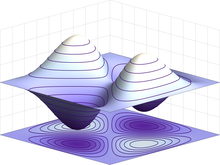|
Dupin indicatrixIn differential geometry, the Dupin indicatrix is a method for characterising the local shape of a surface. Draw a plane parallel to the tangent plane and a small distance away from it. Consider the intersection of the surface with this plane. The shape of the intersection is related to the Gaussian curvature. The Dupin indicatrix is the result of the limiting process as the plane approaches the tangent plane. The indicatrix was introduced by Charles Dupin. Equivalently, one can construct the Dupin indicatrix at point p, by first rotating and translating the surface, so that p is at origin, and the tangent plane is the xy-plane. Now the contour plot of the surface are the Dupin indicatrices.  ClassificationFor elliptical points where the Gaussian curvature is positive the intersection will either be empty or form a closed curve. In the limit this curve will form an ellipse aligned with the principal directions. The curvature lines make up the major and minor axes of the ellipse. In particular, the indicatrix of an umbilical point is a circle. For hyperbolic points, where the Gaussian curvature is negative, the intersection will form a hyperbola. Two different hyperbolas will be formed on either side of the tangent plane. These hyperbolas share the same axis and asymptotes. The directions of the asymptotes are the same as the asymptotic directions. In particular, the indicatrix of each point on a minimal surface is two lines intersecting at right angles, which each make a 45-degree angle with the two curvature lines. For parabolic points, where the Gaussian curvature is zero, the intersection will form two parallel lines. The direction of those two lines are the same as the asymptotic directions. In particular, the indicatrix of each point on a developable surface is a pair of lines parallel to the generatrix. For more complex cases where all the second-degree derivatives are zero, but higher-degree derivatives are nonzero, the Dupin indicatrix is more complex. For example, the monkey saddle has Dupin indicatrix in the shape of six-pointed hyperbola.   See alsoReferences
|